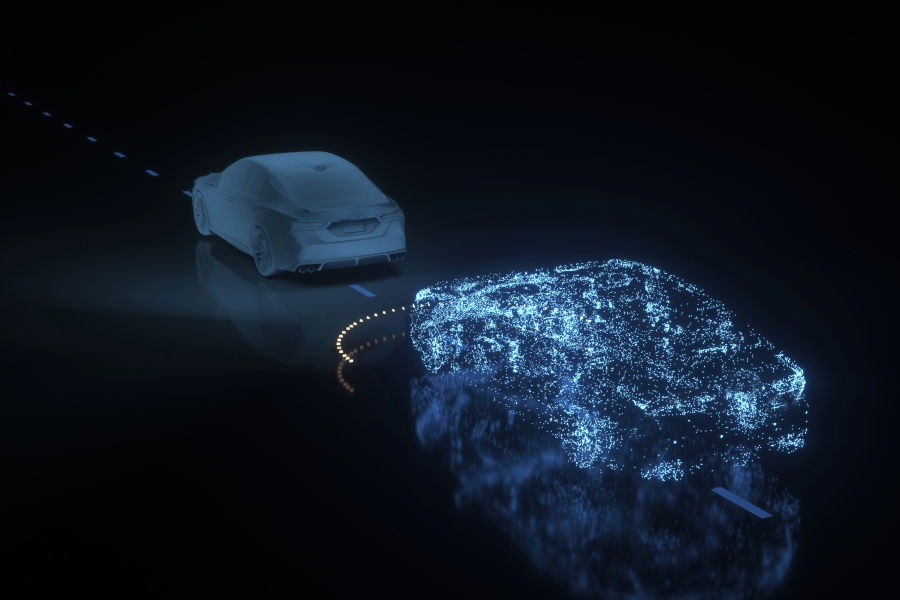In 2020, public perception continues to focus on the question of what type of powertrain will dominate the passenger car market in Europe over the next decade. At the same time, an often misinterpreted, substantial disruption could change the course of mobility in the long term: fully autonomous vehicles. The 3rd part of our Powertrain Scenarios 2030+ shows a future scenario in which this technology will replace the private car due to its economic benefits.
The mobility behavior of Europeans has changed fundamentally. In 2025, following the availability of “level 5”- automated cars, the European Union created the legal basis for the extensive use of autonomous vehicles in order to avoid economic disadvantages compared to the US and China. The subsequent introduction of autonomous door-to-door services („Transport as a Service“, TaaS) rapidly displaced the private-owned car model.
In this scenario, already 75% of passenger kilometers are covered by TaaS in 2030.
The usage of TaaS does not lead to any investments, obligations or lock-in for the consumer, like video streaming, so users tested the offerings early on and increased usage with growing satisfaction. Due to the significantly lower costs compared to the maintenance of an private owned car, the utilization grew strongly even in rural areas, where travel costs and waiting times are higher than in the cities.
The fleet emissions legislation by the EU was adapted to take the entire vehicle life cycle into account („cradle-to-grave“). This eliminated the one-sided penalization of the internal combustion engine and led to a significant reduction in its emission disadvantage when using synthetic fuels.
… However, the impact of the regulation on the propulsion technology of TaaS fleets was small, as the economic efficiency of the vehicles is of utmost importance in this sector.
Initially, TaaS providers used vehicles with electrified internal combustion (HEV) engines powered by synthetic fuels for rural areas due to higher possible ranges and faster refueling. The continuing cost degression, including those for battery technologies, led to a significant drop in the acquisition and operating costs of battery electric vehicles. Despite a further increase in battery capacities across all segments, the total cost of ownership of battery electric vehicles is significantly lower than those of comparable vehicles with combustion engines or fuel cells and dominates the registration statistics, especially due to the high amount of cars used in TaaS fleets. Their operators prefer BEVs for urban and suburban travel services, as the low operating and maintenance costs increase profitability and allow more space and comfort in the vehicles for customers due to a smaller engine-compartment and underfloor batteries. Through the efficient and anticipatory use of the energy contained in the battery by the self-propelled Level 5 system, the system efficiency increases, resulting in lower necessary battery capacities. Over time with further increasing energy density of batteries, autonomous electric vehicles also replaced the ICE-vehicles for those rural areas. Overall, this improves the ecological and economic balance of Europe.
Due to inevitable higher electricity costs for production and storage of hydrogen in comparison to direct use in BEVs, only a few TaaS-operators in remote (and cold) northern European regions use fuel cell-electric vehicles in 2030. Fuel cells are widely used in industries with high-energy requirements, such as heavy commercial vehicles.
As TaaS market penetration grew large enough, a critical mass of vehicle owners began to use their own vehicles less and less and finally tried to sell them.

For these users, owning a new vehicle (regardless of the powertrain) is no longer an option: this initiated a domino effect in the mobility ecosystem. The lack of capacity utilisation led to the disappearance of petrol stations, vehicle dealers and workshops – first in the cities and subsequently in rural areas. In consequence, the use of an own, non-autonomous car became more time-consuming and expensive because of the detours for refueling and the service for vehicle became more and more frequent. Due to the disruption, the demand for spare parts collapses, which aggravates the market situation for suppliers. In addition, insurance premiums for human drivers increased because the insurance industry referred to their higher accident statistics. While this made the use of one’s own car increasingly unattractive, the cost advantage and convenience of TaaS increased due to higher market penetration. This self-reinforcing process completely disrupted the passenger car business and related industries in particular.
In your opinion, how will Transport-as-a-Service evolve? This European scenario derives a fundamental change for the future powertrain portfolio and the market for passenger cars. What else could happen if costumers start to change the way they think about cars as they did for example with owning DVDs vs. shifting the risk to the provider of video streaming?
So how do you rate this matter?
A mobility Scenario by
R.Troeger@consulting4drive.com
I.Schlueter@consulting4drive.com
J.Wiesner@consulting4drive.com
Upcoming Scenario 4 features a more conventional future of Europe’s mobility in 2030, where the industry changes only marginally. Stay tuned!


